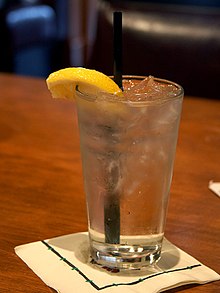Entropi

Entropi adalah salah satu besaran termodinamika yang mengukur energi dalam sistem per satuan temperatur yang tak dapat digunakan untuk melakukan usaha. Mungkin manifestasi yang paling umum dari entropi adalah (mengikuti hukum termodinamika), entropi dari sebuah sistem tertutup selalu naik dan pada kondisi transfer panas, energi panas berpindah dari komponen yang bersuhu lebih tinggi ke komponen yang bersuhu lebih rendah. Pada suatu sistem yang panasnya terisolasi, entropi hanya berjalan satu arah (bukan proses reversibel/bolak-balik). Entropi suatu sistem perlu diukur untuk menentukan bahwa energi tidak dapat dipakai untuk melakukan usaha pada proses-proses termodinamika. Proses-proses ini hanya bisa dilakukan oleh energi yang sudah diubah bentuknya, dan ketika energi diubah menjadi kerja/usaha, maka secara teoretis mempunyai efisiensi maksimum tertentu. Selama kerja/usaha tersebut, entropi akan terkumpul pada sistem, yang lalu terdisipasi dalam bentuk panas buangan.
Pada termodinamika klasik, konsep entropi didefinisikan pada hukum kedua termodinamika, yang menyatakan bahwa entropi dari sistem yang terisolasi selalu bertambah atau tetap konstan. Maka, entropi juga dapat menjadi ukuran kecenderungan suatu proses, apakah proses tersebut cenderung akan "terentropikan" atau akan berlangsung ke arah tertentu. Entropi juga menunjukkan bahwa energi panas selalu mengalir secara spontan dari daerah yang suhunya lebih tinggi ke daerah yang suhunya lebih rendah.
Entropi termodinamika mempunyai dimensi energi dibagi temperatur, yang mempunyai Satuan Internasional joule per kelvin (J/K).
Kata entropi pertama kali dicetuskan oleh Rudolf Clausius pada tahun 1865, berasal dari bahasa Yunani εντροπία [entropía], εν- [en-] (masuk) dan τροπή [tropē] (mengubah, mengonversi).[2][note 2]
Catatan
- ^ In complex systems of molecules, such as at the critical point of water or when salt is added to an ice-water mixture, entropy can either increase or decrease depending on system parameters, such as temperature and pressure. For example, if the spontaneous crystallization of a supercooled liquid takes place under adiabatic conditions the entropy of the resulting crystal will be greater than that of the supercooled liquid (Denbigh, K. (1982). The Principles of Chemical Equilibrium, 4th Ed.). In general, however, when ice melts the entropy of the adjoined hot and cold bodies increases. Some further tutorials: Ice-melting (example by Journal of Chemical Education—subscription required); Ice-melting and Entropy Change (example by The American Heritage Book of English Usage—archive.org copy); Ice-melting and Entropy Change (discussion by Western Washington University—archive.org copy)
- ^ Sebuah "mesin" dalam konteksnya disini termasuk juga organisme biologis.
Referensi
- ^ Clausius, Rudolf (1862). Communicated to the Naturforschende Gesellschaft of Zurich, January 27, 1862; published in the Vierteljahrschrift of this Society, vol. vii. p. 48; in Poggendorff’s Annalen, May 1862, vol. cxvi. p. 73; in the Philosophical Magazine, S. 4. vol. xxiv. pp. 81, 201; and in the Journal des Mathematiques of Paris, S. 2. vol. vii. p. 209.
- ^ "Entropy". Online Etymology Dictionary. Diakses tanggal 2008-08-05.
Bacaan lebih lanjut
- Ben-Naim, Arieh (2007). Entropy Demystified. World Scientific. ISBN 981-270-055-2.
- Dugdale, J. S. (1996). Entropy and its Physical Meaning (edisi ke-2nd). Taylor and Francis (UK); CRC (US). ISBN 0-7484-0569-0.
- Fermi, Enrico (1937). Thermodynamics. Prentice Hall. ISBN 0-486-60361-X.
- Gyftopoulos, E.P. (1991, 2005, 2010). Thermodynamics. Foundations and Applications. Dover. ISBN 0-486-43932-1. Parameter
|coauthor=yang tidak diketahui mengabaikan (|author=yang disarankan) (bantuan); Periksa nilai tanggal di:|year=(bantuan) - Kroemer, Herbert (1980). Thermal Physics (edisi ke-2nd). W. H. Freeman Company. ISBN 0-7167-1088-9. Parameter
|coauthor=yang tidak diketahui mengabaikan (|author=yang disarankan) (bantuan) - Penrose, Roger (2005). The Road to Reality: A Complete Guide to the Laws of the Universe. New York: A. A. Knopf. ISBN 0-679-45443-8.
- Reif, F. (1965). Fundamentals of statistical and thermal physics. McGraw-Hill. ISBN 0-07-051800-9.
- Goldstein, Martin; Inge, F (1993). The Refrigerator and the Universe. Harvard University Press. ISBN 0-674-75325-9. Pemeliharaan CS1: Menggunakan parameter penulis (link)
- vonBaeyer; Hans Christian (1998). Maxwell's Demon: Why Warmth Disperses and Time Passes. Random House. ISBN 0-679-43342-2.
- Entropy for beginners
- Biel, R. and Mu-Jeong Kho (2009) "The Issue of Energy within a Dialectical Approach to the Regulationist Problematique Diarsipkan 2012-05-08 di Wayback Machine.," Recherches & Régulation Working Papers, RR Série ID 2009-1, Association Recherche & Régulation: 1–21.
Pranala luar

- Entropy – A Basic Understanding A primer for entropy from a chemical perspective
- Interactive Shockwave Animation on Entropy
- Max Jammer (1973). Dictionary of the History of Ideas: Entropy Diarsipkan 2013-01-27 di Wayback Machine.
- Frank L. Lambert; entropysite.oxy.edu Diarsipkan 2013-01-14 di Wayback Machine. – links to articles including simple introductions to entropy for chemistry students Diarsipkan 2006-07-02 di Wayback Machine. and for general readers Diarsipkan 2012-11-22 di Wayback Machine..
- Thermodynamics Diarsipkan 2017-02-28 di Wayback Machine. – a chapter from an online textbook
- Entropy on Project PHYSNET
- Entropy – an Open Access journal
- An Intuitive Guide to the Concept of Entropy Arising in Various Sectors of Science – a wikibook on the interpretation of the concept of entropy.







